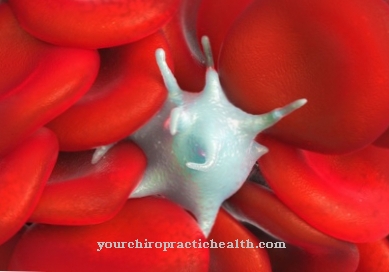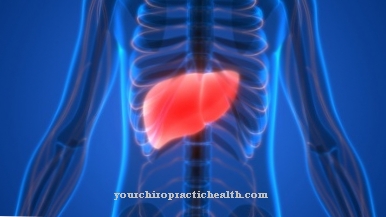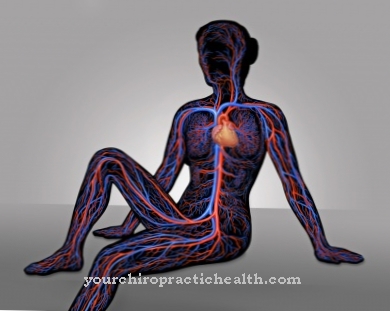At a Poisoning Toxic substances arise in the organism during metabolism. It can occur when foreign substances (xenobiotics) are broken down in the body. When using prodrugs, a mild and deliberate form of poisoning occurs.
What is the poisoning?
.jpg)
A poisoning or Toxification indicates a process in the organism which converts ineffective or weakly toxic foreign substances into biologically effective or even highly toxic substances within the framework of the metabolism.
Normally, foreign substances absorbed from the outside, which are either of no significance for the body or can cause harmful effects, are transformed in the liver into ineffective and readily water-soluble compounds so that they can be excreted via the kidneys, sweat or breath. The aim is to detoxify the body.
However, the enzymes are unspecific. It can happen that certain ineffective substances on the contrary become effective or even toxic. In some cases this is explicitly wanted. For example, some drugs only develop their effectiveness through a biotransformation in the body. However, highly toxic substances can also arise that damage the organism.
Everyone is endowed with individual enzymes, so that a drug is not toxic or effective everywhere to the same extent. This is one of the causes of various drug side effects occurring.
Function & task
The toxification of xenobiotics is usually problematic for the body. In the case of drugs known as prodrugs, however, this change is intentional. These substances only form effective metabolites during detoxification in the liver. This applies to the drugs codeine, clopidogrel, levodopa, metamizole, phenacetin and omeprazole, among others.
For example, codeine is converted into morphine or phenacetin into paracetamol.Levodopa is considered a precursor to adrenaline, noradrenaline, or dopamine used to treat Parkinson's. The thyroid drug carbimazole or the sleeping pill chlordiazepoxide also only become an effective substance through a biotransformation in the body.
Regardless of their chemical structure, all substances in the organism undergo a biotransformation after being ingested in the liver. The aim of this metabolism is to detoxify the body. The substances are converted into a water-soluble form so that they can be quickly removed from the body. In a first phase, unspecific reactions take place that apply equally to all foreign substances. This leads to oxidation, reduction and hydrolysis reactions. All compounds are given certain functional groups. In some cases existing functional groups are changed. These reactions are catalyzed by the enzymes of the cytochrome P-450 system.
In a second phase, conjugation reactions take place. The metabolites of the foreign substances are connected to the body's own water-soluble substances via the functional groups. This leads to conjugation reactions with glucuronic acid, acyl and acetyl residues, amino acids, methyl groups, glutathione or sulfates. The metabolites can be transported in this form.
In the third phase, they are now transported out of the cells via transport molecules and then with the bloodstream and the lymphatic system through the body to the kidneys.
The conversion of ineffective substances into effective or even toxic compounds can happen during their first passage through the liver as part of the so-called first pass effect. In the case of a first-pass effect, the inactive substances migrate via the enterohepatic circulation through the liver, where they are biochemically converted into an active substance.
Illnesses & ailments
In the event of poisoning or toxification, however, ineffective compounds often result in extremely toxic substances. During the metabolization of alcohols, aldehydes and carboxylic acids are formed in the first phase. Usually this is not a problem, as the resulting compounds are usually non-toxic. Although methanol is primarily non-toxic, its metabolism results in toxic formaldehyde as aldehyde and corrosive formic acid as carboxylic acid. Both substances are far more toxic than methanol. Drinking methanol can lead to blindness or even death.
Toxification can also occur if the starting substances are used in too high doses. The increased enzyme activation results in many activated metabolites in the first phase, which cannot be inactivated as quickly as the capacities for the second phase are insufficient. The activated metabolites then act as free radicals and damage the cell and genetic material.
When cells are damaged, lysosomal enzymes are released which can completely destroy the cells. Liver and kidneys in particular are damaged. An example of this effect is taking a high dose of paracetamol. Paracetamol poisoning can result in death from liver degradation.
In some cases, toxification can also set in in the second phase of metabolism. This can happen with kidney failure. The morphine metabolite morphine-6-glucuronide is usually quickly removed from the kidneys, but it has been found that if the kidneys are weak, a further conversion takes place, which makes the metabolite even more effective than the starting material. However, phase 2 toxification is very rare.
Another example of toxification is ragwort poisoning. The starting materials in ragwort are pyrrolizidine alkaloids (PA), which are not themselves toxic. If the contact with the alkaloid is not very intense, it is broken down well in the body. However, if the body has been exposed to high amounts, the intermediate metabolites cannot be broken down quickly enough. They then attack liver cells and genetic material.



























